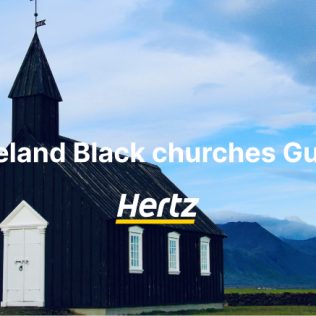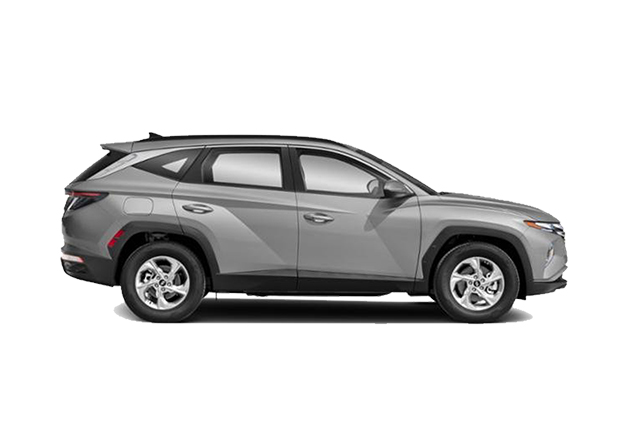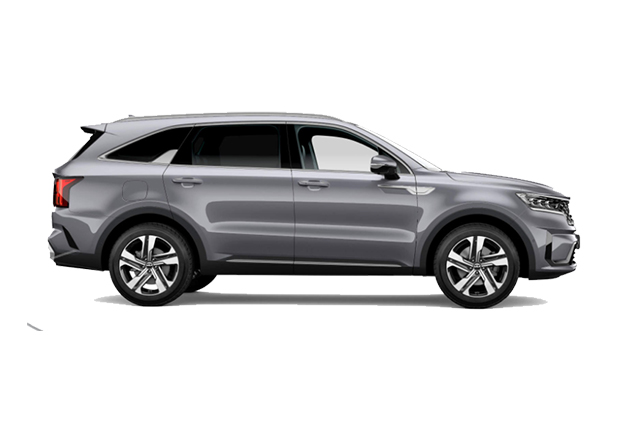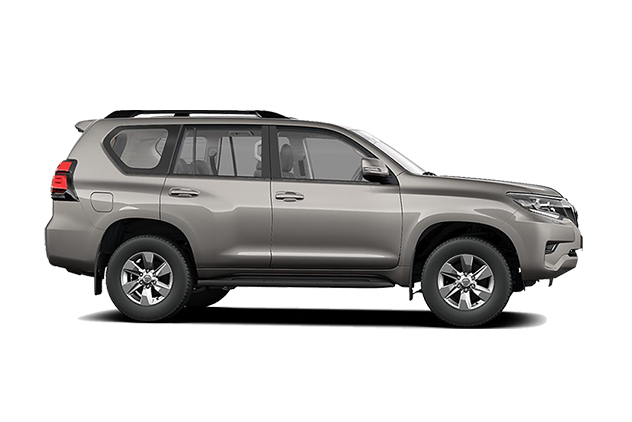In this article, we will explore the Budakirkja black church in Iceland, along with some of the others that you should add to your Iceland itinerary.
Iceland is home to over 350 churches, with many of them built in seemingly random places across the country.
Nearly 70% of Icelanders are considered Christian, and the history of Christianity is evident through the high saturation of chapels, each entirely different from the next. Icelandic churches have an architectural uniqueness, with a blend of modern and naturalistic designs featuring clean lines, geometric shapes, and elements that echo the dramatic landscapes of the island.
Iceland is especially known for its black churches. While Budakirkja is the most iconic black church in Iceland, there are actually many other black churches in the country that are worth visiting as well.
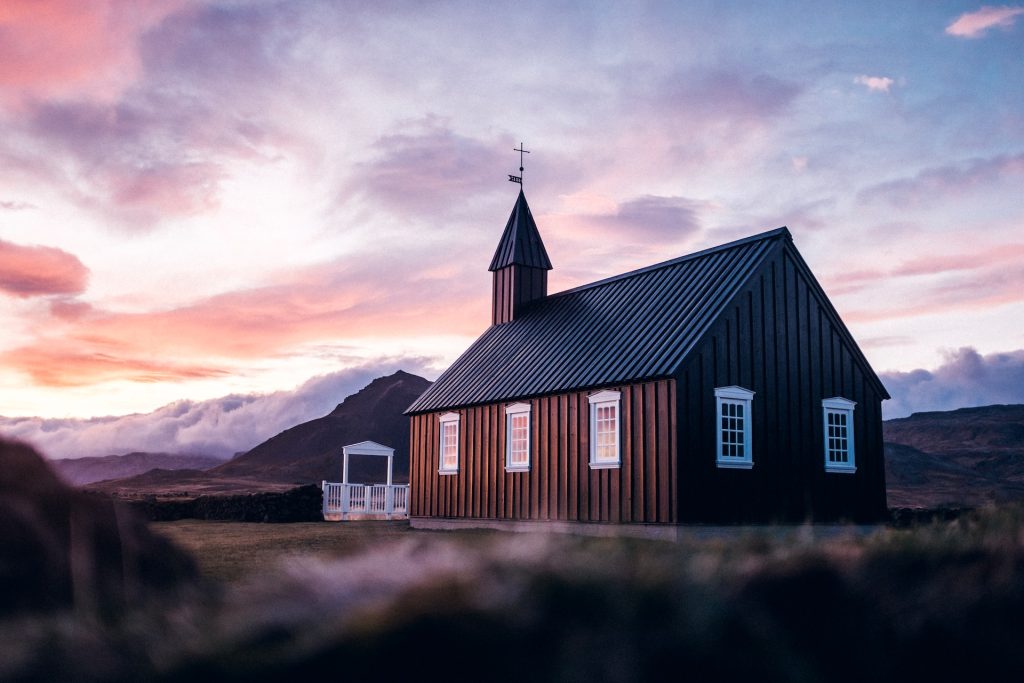
“The” Black Church in Iceland: Budakirkja
Budakirkja is a black wooden church surrounded by a field of lava field and stands as a solitary monument against the Icelandic landscape. Also known as the Black Church at Budir, close to hotel Budir, this black church is a prime example of historical resilience and architectural beauty. This iconic black church has become one of the top Iceland attractions, drawing photographers and explorers alike.
Budakirkja was first built in 1703 when the first version of the church was constructed on the spot it occupies today. Over the centuries, the church has undergone various transformations, with the most recent reconstruction taking place in 1987.
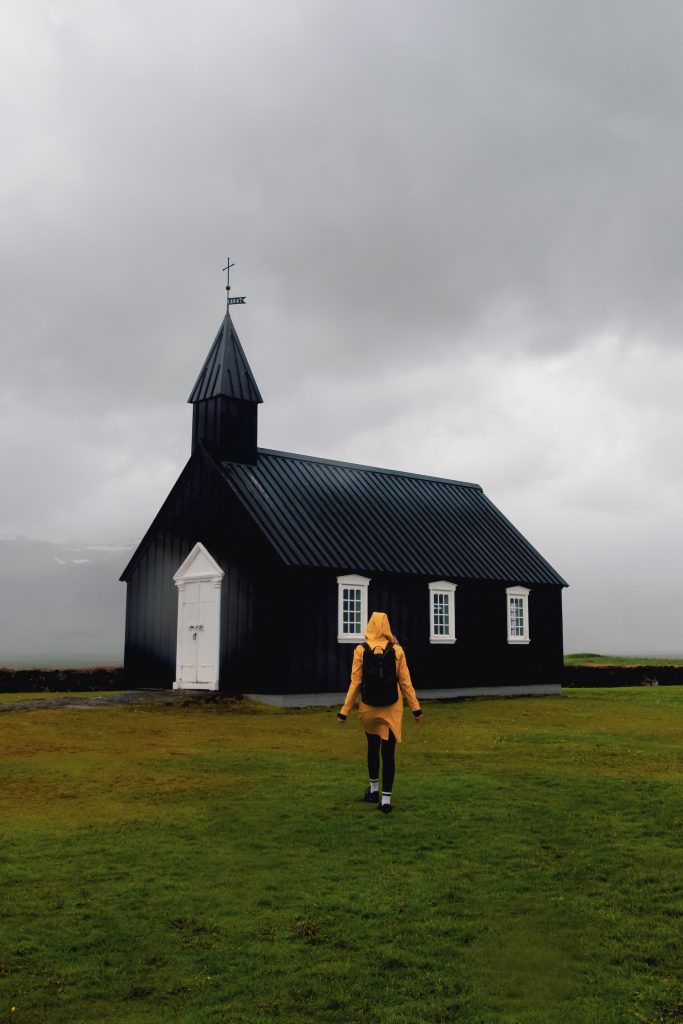
The historic graveyard surrounding the church grounds serves as a reminder of the community that has called this place home throughout the years, along with multiple relics housed within the church, including a bell and chalice. Budakirkja is renowned for its distinctive black exterior, a characteristic shared with many churches in Iceland. The tradition of tarring church exteriors served a practical purpose – protecting the structures from the harsh Icelandic elements.
Situated 179 kilometers (111 miles) from Reykjavik, Budakirkja is easily accessible year-round. The best way to explore the church and the surrounding snæfellsnes peninsula is with a rental car. Driving provides the freedom to linger at attractions, discover hidden gems, and appreciate the breathtaking scenery along the way.
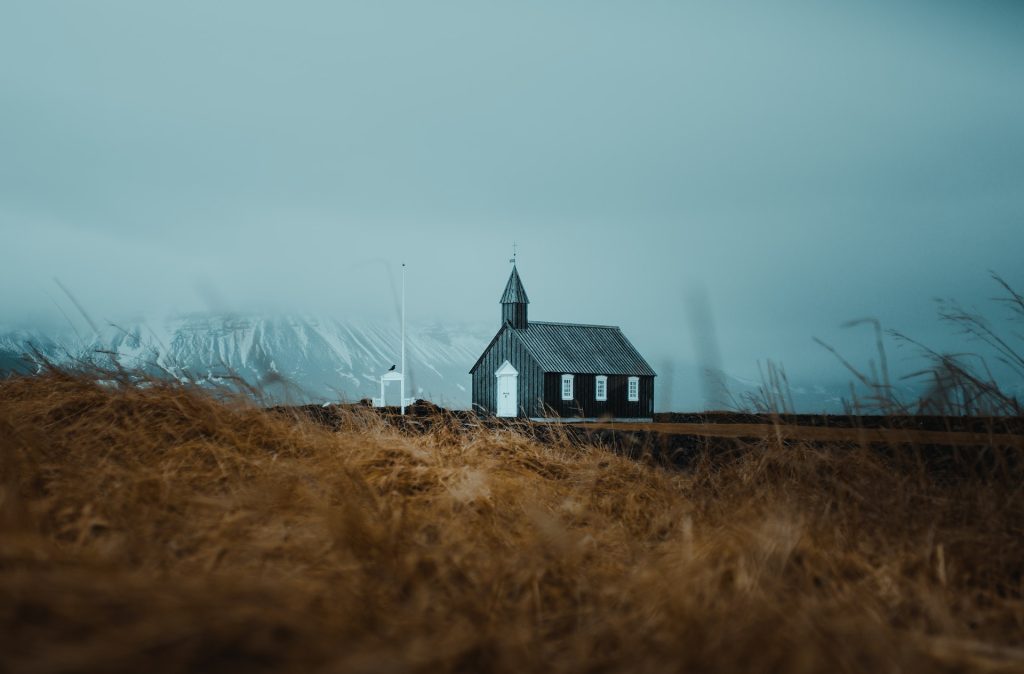
While Budakirkja is accessible all year long, there are things to keep in mind when visiting the church across the different seasons. While the summer in Iceland offers the most mild and pleasant temperatures, it also is the high season, meaning prices are higher and there are more tourists. Iceland in the winter is colder, and the weather is more variable, however, the church looks beautiful against the snowy backdrop, and prices are most affordable.
May in Iceland is one of the best times to experience Budakirkja. Advantages include affordability, increased daylight, and improved weather conditions, with average temperatures ranging from 2°C (36°F) to 11°C (53°F).
Black Church Closest to Iceland Airport: Kirkjuvogskirkja
Just around the corner from the Keflavik airport on the Southern Peninsula of Iceland, you’ll find the black church of Kirkjuvogskirkja. Constructed in 1860-61, the church’s creation reportedly cost the equivalent of 300 cows at that time.
Over the years, the church underwent various updates, with its original appearance altered and painted in light colors. However, during the renovation of 1970-72, the church was meticulously restored to its original state, including covering Kirkjuvogskirkja in black tar, as per the tradition.
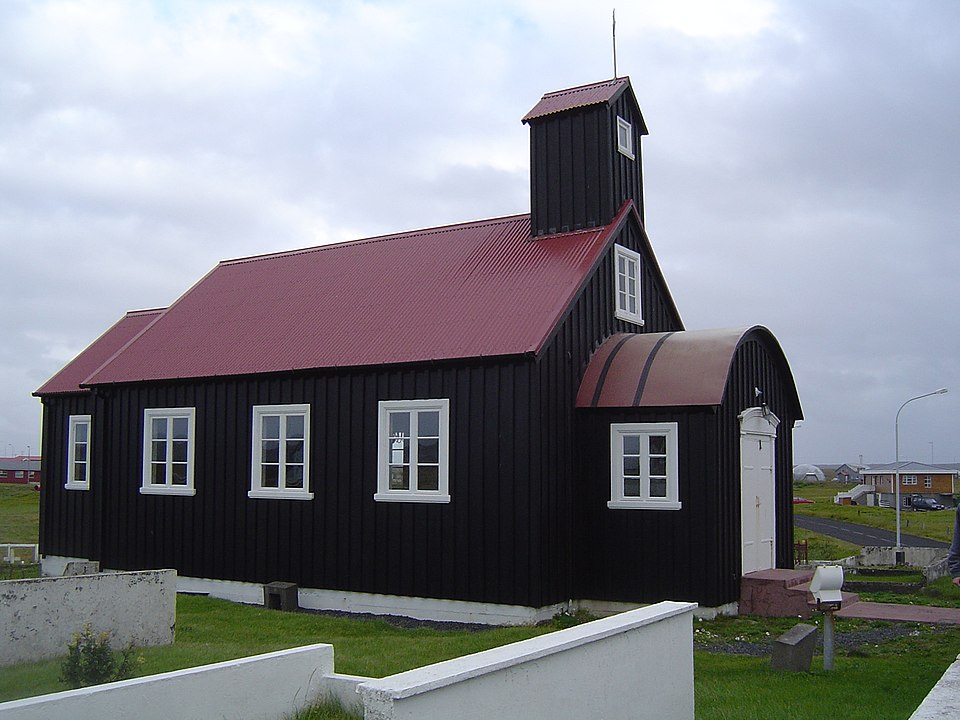
CC BY-SA 3.0 by Christian Wirth via Wiki
Kirkjuvogskirkja is located in Reykjanesbær, near the hamlet Hafnir, less than a 20-minute drive from Keflavik Airport. The drive takes approximately 50 minutes (54.8km or 34 miles) by car from Reykjavik, making it an accessible destination for travelers arriving or departing from Iceland’s airport.
Whether you are on a 10-day Iceland road trip or squeezing in a short Iceland stopover, Kirkjuvogskirkja black church is an easy and convenient stop.
While you can visit Kirkjuvogskirkja year-round, the summer months are the most due to the milder climate, extended daylight hours, and a variety of other activities available in the area, located only 20 minutes away from Iceland’s famous Blue Lagoon.
Black Church on Reykjanes Peninsula: Krýsuvíkurkirkja
Krýsuvíkurkirkja is a small and disused black church that stands out against the barren, tranquil, and open landscape of the Reykjanes Peninsula. This simple wooden church was originally constructed in 1857, serving as a parish church, and it was later used as living quarters.
After being abandoned for a period of time, it went into the custody of the National Guard and was restored in 1964. Unfortunately, the church was burnt to the ground in 2010, for which 4 teenagers were charged. An exact replica of the church was reconstructed in its place, which was consecrated in 2022.
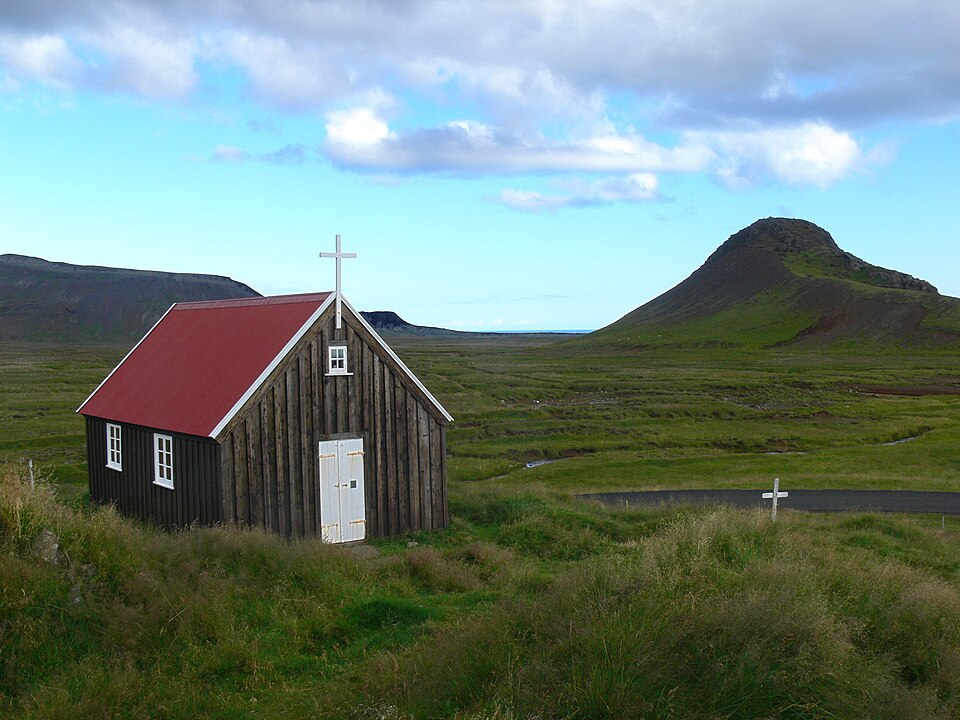
CC BY-SA 2.0 de by Christian Bickel via Wiki
The church is located about 43 minutes (39km or 24 miles) by car from Reykjavik, south out of the city on Route 40. The location isn’t incredibly well-marked, but there is a spot to pull off and then you’ll have to walk to the church by foot. Beyond Krýsuvíkurkirkja, the Reykjanes Peninsula offers other interesting sights for those who choose to explore further, such as Krýsuvik Lake, Gunnuhver hot spring, and the cliffs and rock formations of Reykjanestá.
For those planning a visit to Krýsuvíkurkirkja, the months from April through September are the best since you’ll be spending your time outdoors, and the weather in Iceland is much more agreeable. That said, the church is still beautiful to see in the winter.
Black Church Near West Iceland: Brautarholtskirkja
The iconic black church, Brautarholtskirkja, traces its roots back to the Viking settlement era, and has undergone multiple transformations and restoration efforts to preserve its unique heritage.
The original church, built shortly before the year 900 by the Viking settler Örlygur Hrappson, laid the foundation for what would eventually become Brautarholtskirkja. The present-day church was constructed in 1857, and in 1987, a restoration initiative began to bring it back to its original appearance. Standing on the top of a hill, this wooden church is visible from the surrounding area and is still operational, with mass being held approximately once per month.
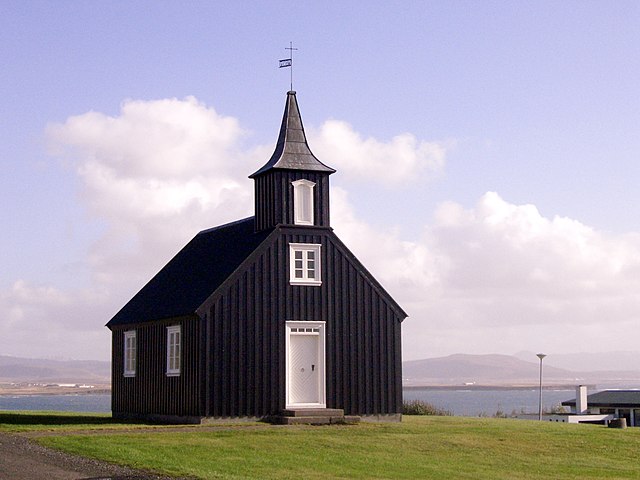
Tilvísun höfundarréttar: I, Eysteinn Guðni Guðnason
Situated in Kjalarnes, the church is conveniently located just north of Reykjavík, making it easily accessible by rental car. It takes approximately 33 minutes (36km or 22 miles) to drive from the capital, but another good option is to park in the small neighborhood of Grundarhverfi and walk about 30 minutes to the church. Brautarholtskirkja is very near to the water, so visitors can also wander down to explore the pebbled beach.
Similarly to other black churches in Iceland, the summer months provide the ideal opportunity to visit Brautarholtskirkja. However, if you’re visiting Iceland during the Christmas holidays, you may be able to attend a special mass held inside the church, providing a unique opportunity to experience the culture of Icelandic people.
On the Westman Island: Stafkirkjan (Heimaey Stave Church)
Stafkirkjan, also known as Heimaey Stave Church, is one of the most distinctive black churches in Iceland and represents the enduring ties between Iceland and Norway. The Medieval-style structure, a gift from Norway to Iceland, was constructed in 2000 to commemorate the 1,000th anniversary of Iceland’s conversion to Christianity. The church reflects the medieval architectural style, with every piece of timber used in the construction being specially selected and worked by hand in dedication to preserving historical traditions.
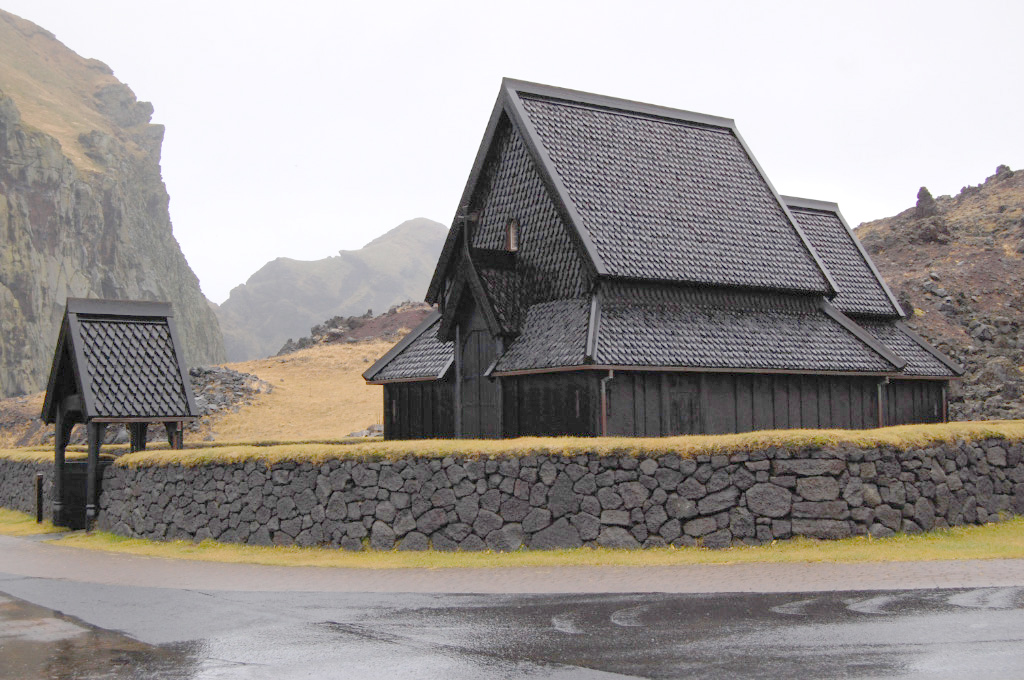
CC BY 2.0 by Sakaris Ingolfsson via Wiki
Heimaey Stave Church is located on the Westman Islands, by the harbor in Heimaey, meaning travelers will need to take a ferry to get there. The crossing takes about 40 minutes, and the ferry leaves from Landeyjahöfn on Iceland’s South Coast, located not far from the iconic Skogafoss waterfall. takes around 2 hours to drive from Reykjavik to the ferry terminal, heading south on the Route 1 Ring Road.
Choosing to visit Stafkirkjan between April and September enhances the overall experience since the ferry and island can become windy and chilly during the winter. Additionally, during the summer, Iceland’s puffins populate the region, and the Westman Islands are one of the best places in the country to see them.
What is the Best Rental Car Option to Visit the Black Church in Iceland
Exploring Iceland’s iconic Black Churches is an experience filled with breathtaking landscapes and opportunities to learn about Icelandic culture. Unlike other European countries with easily accessible public transportation, Iceland’s greatest wonders are often in remote areas, requiring a reliable rental car for exploration.
The key to a successful trip lies in selecting the right rental car, considering various factors such as time of year, size of your group, amount of luggage, and areas you plan to visit. Below, we break down the factors influencing your rental car choice and provide insights into why opting for a 4X4 vehicle may be the best decision for your exploration of the black churches in Iceland and beyond.
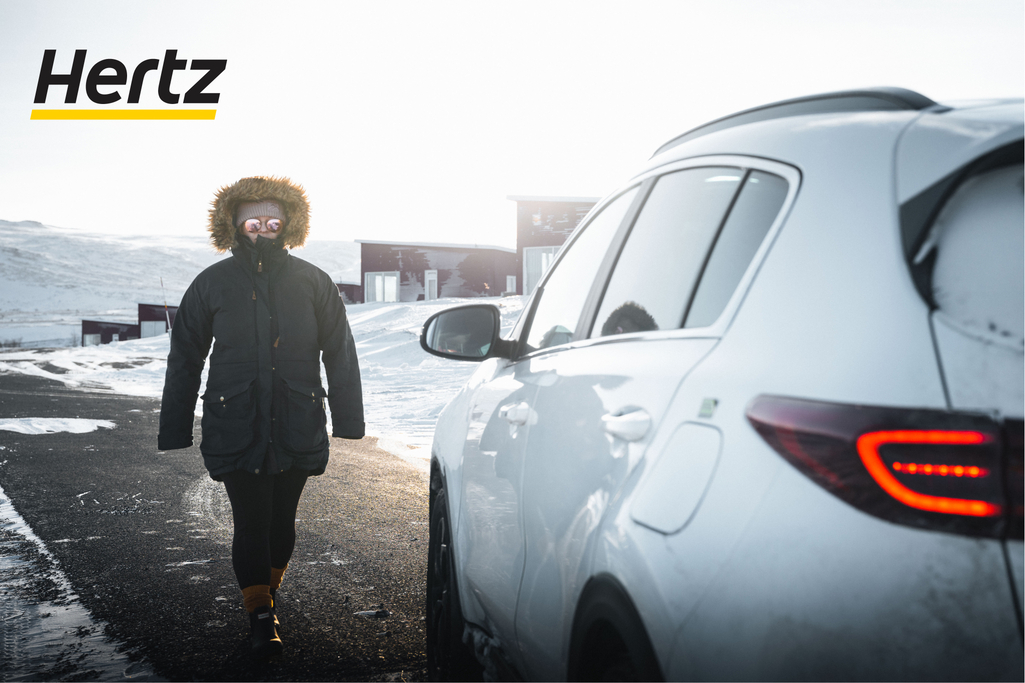
Seasonality
During the summer months, when the roads are generally clear, and weather conditions are mild, a 2WD compact or mid-size car may suffice for visiting Iceland’s black churches, with the exception of parts of the Snaefellsnes Peninsula that only have gravel roads.
If your travel includes the Ring Road, it can be driven with most 2WD vehicles, but for a longer Ring Road trip, a 4X4 vehicle would be a better option to give you the opportunity to explore other terrain along the way. Also, if you plan to use any F-roads to visit the highland areas in summer, a 4WD car is required by law.
The winter months call for the reliability of a 4X4 rental vehicle to navigate through potentially icy or snow-covered roads. Iceland winter weather and road conditions can be very challenging.
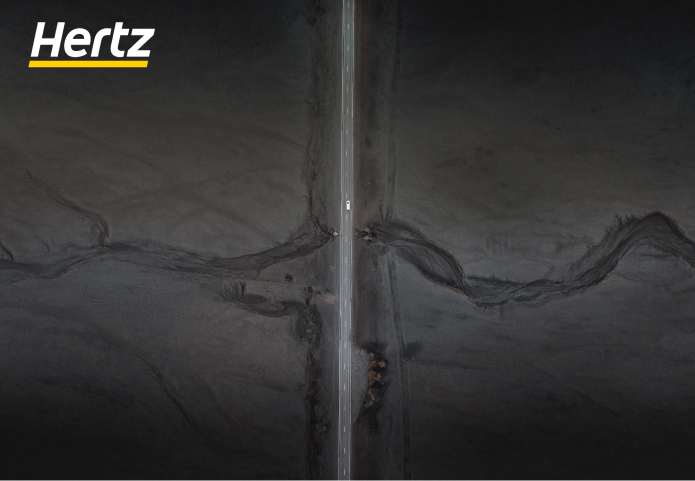
Luggage
The amount of luggage you plan to bring plays a crucial role in determining the appropriate car size for your Icelandic road trip. When selecting a rental car, consider storage capacity and trunk space to ensure that your luggage comfortably fits without compromising the comfort of passengers. If you’re traveling with a larger group or carrying substantial baggage, opting for a spacious 4X4 vehicle becomes essential.
Number of People
For solo or couple travelers, a compact or economy car offers the ideal balance of fuel efficiency and maneuverability. If you’re traveling with three or more people, a midsize to full-size car provides the necessary space and comfort for an enjoyable road trip.
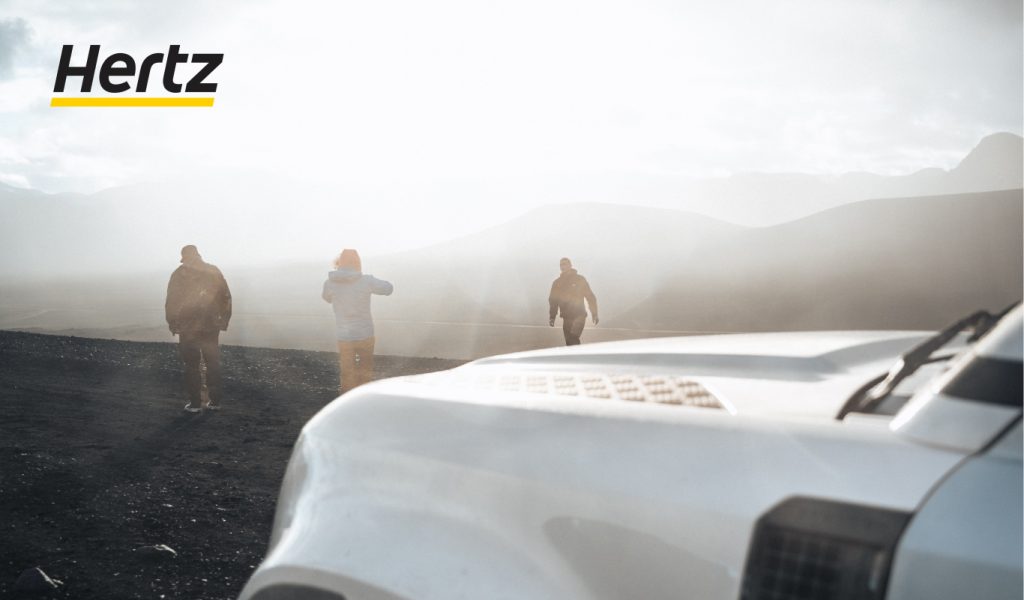
When the group expands to four or more individuals, a 4X4 SUV becomes the best choice, not only for accommodating passengers but also for tackling diverse terrains and ensuring a safe and versatile trip. Tailoring your choice to the size of your group ensures everyone travels comfortably and makes the most of the trip along the way.
Where Else You’re Visiting
The type of rental car you choose should include all the destinations you plan to explore. While the route to the black churches may be accessible via well-maintained and paved roads, if your journey extends to more challenging terrains such as the Westfjords, Highlands, or gravel and F-roads, opting for a 4X4 becomes paramount. Iceland’s varied landscapes demand versatility, and a 4X4 vehicle ensures you can confidently navigate through unpaved paths, river crossings, and rocky terrains.

Explore the Black Church Iceland
Incorporating the exploration of Iceland’s Black Churches into your itinerary is a journey that takes you through some of the most breathtaking landscapes in Iceland. Choosing the right rental car is an important part of the experience. With Hertz Iceland, you gain the ultimate freedom to explore Iceland at your own pace, unlocking the full potential of your adventure. We encourage you to book your rental car online and in advance for a seamless and reliable journey to the Iceland black churches.
